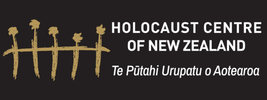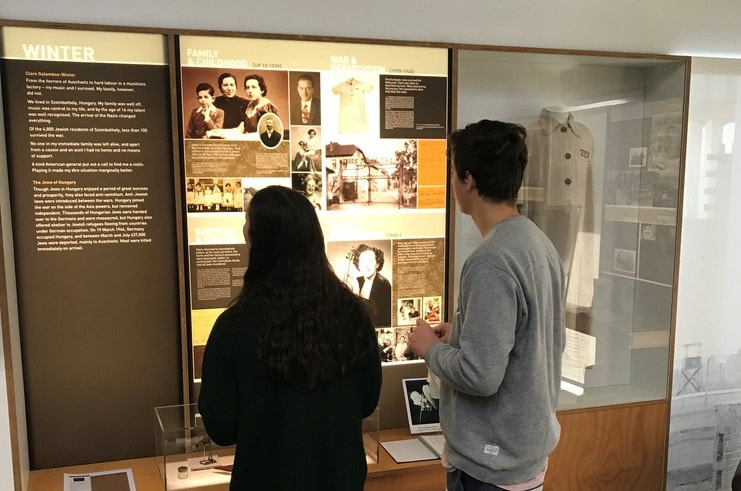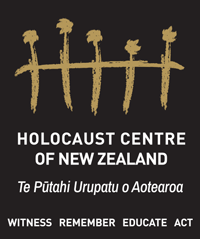VISIT OUR CENTRE - General Information
Opening Hours
The Holocaust Centre of New Zealand (“HCNZ”) is open to the public Sunday to Friday 10am – 1pm, and outside of these hours by prior arrangement. We are closed to the public when school and adult group booked sessions are taking place, and on Saturdays and some public and Jewish Holidays. (Closed Dates)
Admission
General Entry is free - however we appreciate any and all donations. HCNZ is a registered charitable entity and donations over $5 are tax-deductible.
There is a charge per person for school and group bookings (see school and group booking info links below)
The Holocaust Centre of New Zealand (“HCNZ”) is open to the public Sunday to Friday 10am – 1pm, and outside of these hours by prior arrangement. We are closed to the public when school and adult group booked sessions are taking place, and on Saturdays and some public and Jewish Holidays. (Closed Dates)
Admission
General Entry is free - however we appreciate any and all donations. HCNZ is a registered charitable entity and donations over $5 are tax-deductible.
There is a charge per person for school and group bookings (see school and group booking info links below)
Key Features of our Core Exhibition
Our core exhibition focuses on the Holocaust and the uniquely New Zealand connection, specifically:
Our core exhibition focuses on the Holocaust and the uniquely New Zealand connection, specifically:
- Learn about the challenges Holocaust Survivors and refugees from Nazi occupied-Europe faced in New Zealand
- Jewish life before, during, and after the Holocaust
- Two parallel Timelines showing events in Europe and the New Zealand responses
- The experience of the Holocaust - as told through first-hand account testimonies of Holocaust survivors who came to New Zealand to make a new life. Our display panels feature explanatory texts, interspersed with personal stories of survivors, quotes, original photographs and images, artefacts and video interviews.
- The story of the collection of 1.5 million buttons, and the Children's Holocaust Memorial, created to remember & honour the 1.5 million children killed during the Holocaust (scale model on-site, the memorial is travelling New Zealand)
- A map of Europe's Jewish population pre and post WWII, showing the impact of the Holocaust on the population.
- Panels devoted to the story of the Deckston Orphanage
- The Universal Declaration of Human Rights, created in response to the atrocities of the Holocaust and WWll, setting out the fundamental human rights for all people and all nations.
During the year, we often stage temporary exhibitions; for example:
'Auschwitz to Aotearoa: Survival in Nazi Concentration Camps' - By Dr Simone Gigliotti & Anna Chapman
This exhibition is about nine Jewish women from different countries and backgrounds, who have in common their survival of Auschwitz and later settling in New Zealand.
‘Anguish of Liberation - As Reflected in Art’ - by Yad Vashem
This exhibition featured 11 artworks (and the personal stories behind each) created immediately after the liberation and up to 1947. The exhibition looks at how survivors reacted to the liberation through art.
'SPOTS OF LIGHT: To be a Woman in the Holocaust' - by Yad Vashem
This exhibition gives expression to the unique voice of Jewish women in the Holocaust: their choices and responses in the face of the evil, brutality and relentless hardship that they were forced to grapple with.
'Some Were Neighbors: Collaboration & Complicity in the Holocaust' - By USHMM
Some Were Neighbors: Collaboration & Complicity in the Holocaust addresses one of the central questions about the Holocaust: How was it possible? The central role of Hitler and other Nazi Party leaders is indisputable. However, the dependence of these perpetrators on countless others for the execution of Nazi racial policies is less understood. Within Nazi Germany and across German-dominated Europe, circles of collaboration and complicity rippled throughout governments and societies wherever victims of persecution and mass murder lived. Some Were Neighbors examines a variety of motives and pressures that influenced individual choices to act. These influences often reflect fear, indifference, antisemitism, career concerns, community standing, peer pressure, or chances for material gain. It also looks at individuals who did not give in to the opportunities and temptations to betray their fellow human beings, reminding us that there is an alternative to complicity in evil acts—even in extraordinary times.
'Finding Hope: Seeking Refuge in Aotearoa New Zealand' - by HCNZ
Eight pull up banners in a graphic novel style, that explore New Zealand’s response to the Holocaust and the significance of this event on our history.
Addressing such questions as , Did New Zealand do enough before and during the Holocaust? What the was response of the New Zealand government and population to Jews seeking refuge in the country? What impact have Jewish refugees made in New Zealand society? How does New Zealand remember this dark time in world history?
This exhibition can be loaned out to schools.
'Auschwitz to Aotearoa: Survival in Nazi Concentration Camps' - By Dr Simone Gigliotti & Anna Chapman
This exhibition is about nine Jewish women from different countries and backgrounds, who have in common their survival of Auschwitz and later settling in New Zealand.
‘Anguish of Liberation - As Reflected in Art’ - by Yad Vashem
This exhibition featured 11 artworks (and the personal stories behind each) created immediately after the liberation and up to 1947. The exhibition looks at how survivors reacted to the liberation through art.
'SPOTS OF LIGHT: To be a Woman in the Holocaust' - by Yad Vashem
This exhibition gives expression to the unique voice of Jewish women in the Holocaust: their choices and responses in the face of the evil, brutality and relentless hardship that they were forced to grapple with.
'Some Were Neighbors: Collaboration & Complicity in the Holocaust' - By USHMM
Some Were Neighbors: Collaboration & Complicity in the Holocaust addresses one of the central questions about the Holocaust: How was it possible? The central role of Hitler and other Nazi Party leaders is indisputable. However, the dependence of these perpetrators on countless others for the execution of Nazi racial policies is less understood. Within Nazi Germany and across German-dominated Europe, circles of collaboration and complicity rippled throughout governments and societies wherever victims of persecution and mass murder lived. Some Were Neighbors examines a variety of motives and pressures that influenced individual choices to act. These influences often reflect fear, indifference, antisemitism, career concerns, community standing, peer pressure, or chances for material gain. It also looks at individuals who did not give in to the opportunities and temptations to betray their fellow human beings, reminding us that there is an alternative to complicity in evil acts—even in extraordinary times.
'Finding Hope: Seeking Refuge in Aotearoa New Zealand' - by HCNZ
Eight pull up banners in a graphic novel style, that explore New Zealand’s response to the Holocaust and the significance of this event on our history.
Addressing such questions as , Did New Zealand do enough before and during the Holocaust? What the was response of the New Zealand government and population to Jews seeking refuge in the country? What impact have Jewish refugees made in New Zealand society? How does New Zealand remember this dark time in world history?
This exhibition can be loaned out to schools.
Group and School Bookings
Did You Know the Holocaust Centre of New Zealand Features on the Commonwealth-Walkway?
- The Commonwealth Walkway forms part of a group of walkways in the main cities of Commonwealth nations and territories.
- Wellington Mayor Celia Wade-Brown (2010 - 2016) agreed Wellington should be home to the first Commonwealth Walkway in New Zealand to mark 150 years since the city became the capital city. The Commonwealth Walkway is a network of walkways across the Commonwealth with the aim of inspiring young people to walk for their physical and mental wellbeing.
- The Commonwealth Walkway connects 32 significant monuments, parks, buildings and historic places along a 9km loop in the capital, and takes approximately two hours to complete. The route was developed by a Commonwealth Walkway representative and suggestions from Wellingtonians.
- The Commonwealth Walkway is identified by bronze markers installed in the ground to identify each point of significance. They feature Her Majesty The Queen Elizabeth's EIIR cypher.
- More info at Wellington City Council website

Chair of the Commonwealth Foundation Sir Anand Satyanand places the first Commonwealth Walkway marker at Wai-Titi landing with Jim Walker and Mayor Celia Wade-Brown.
25 July 2015. Wellington CIty Council.
25 July 2015. Wellington CIty Council.
|
Map / Location
The Holocaust Centre of New Zealand is located at the Wellington Jewish Community Centre,
80 Webb Street, Te Aro, Wellington 6011. For more information on access and closure dates go to
PLANNING YOUR VISIT |



